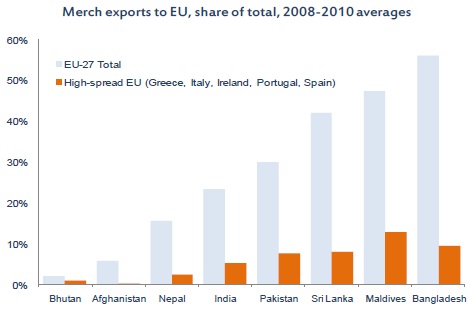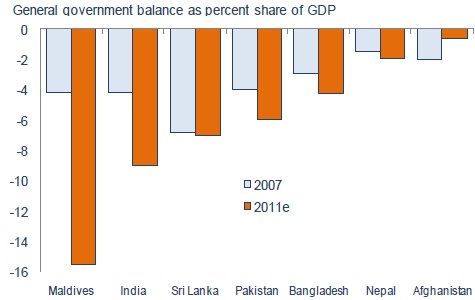Ejaz Ghani outlines two scenarios for South Asia: optimistic and pessimistic. Here are the major points:
Optimistic scenario:
- The optimistic outlook is based on the favourable structural trends including improved governance, the demographic dividend, the rise of the middle class, and the new faces of globalisation.
- All countries in the region have an elected government for the first time since independence. Governance has improved in two ways that will enhance the politics of democratic accountability. The first is the diminishing importance of identity politics, and the second is that the rates of incumbency – the likelihood of a sitting legislator or state government being re-elected – are down.
- The demographic dividend [=(working-age population)/(non-working age population)*100] will benefit growth not only through the swelling of the labour force, as the baby boomers reach working age, but also due to society’s ability to save more because working age happens to be the prime years for savings, and the increased fiscal space that will divert resources from spending on children to investing in infrastructure and technology.
- A massive shift towards a middle class society is already in the making. India’s middle class (daily expenditure of $10-$100 in PPP terms) will rise more rapidly compared to China, because Indian households will benefit more from growth than Chinese households, given the prevailing distribution of income. The size of the middle class will increase from 60 million in 2010 to more than one billion people by 2025. Growth, education, home ownership, formal-sector jobs, and better economic security are cause and consequence of an expanding middle class.
.gif)
- The world has already benefited from global capital flows and trade in goods. It is now the turn of trade in services and migration. Technology has enabled services to be digitised, transported, and traded, long distance, at low cost, without compromising on quality. Trade in services are the fastest growing component of world trade during the last two decades. India’s service export is growing at a much faster pace compared to goods export form China.
- Global migration rates have been sluggish over the last 50 years. But this will change. Current demographic trends suggest a rapidly ageing population in OECD countries, and a young population in South Asia. This generates powerful incentives for labour mobility, as well as unique opportunities for improved global efficiency.
- Growth in the region could be derailed by lopsided spatial transformation, lack of entrepreneurship, large informal sectors, high levels of conflict, gender disparities, and deep pockets of poverty.
- Rapid growth has produced billionaires in India. But, the broad character of the region remains agrarian and rural. This has more to do with the peculiarities of growth patterns -- services-led growth, which is more skill-intensive, compared to manufacturing-led growth, which is less skill-intensive, and the fragmented nature of transformation, than the pace of growth.
- Slow growth in manufacturing despite rapid GDP growth should by itself not be a worry, provided it is not in the way of growth in employment opportunities for unskilled and low-skilled workers at decent wages in industry and services so that these sectors still manage to rapidly pull the underemployed workers in agriculture into gainful employment.
-
Entrepreneurship is central to job creation. But South Asia has too few entrepreneurs. While India has a disproportionately high rate of self-employment and many small firms, this has not as readily translated into as many young entrepreneurial firms as could be hoped. Yet there is no question that entrepreneurship works. Formal-sector job growth has been strongest in regions and industries that have exhibited high rates of entrepreneurship and dynamic economies.
-
The informal sector remains overwhelmingly large and persistent. Around nine out of ten employees in India do not have formal jobs. What is worrying is that informal employment does not seem to disappear with rapid growth. There is a strong association between informality and poverty.
-
South Asia has experienced high levels of internal conflict. Most countries in South Asia are currently immersed in, or are just emerging from, conflicts of varying nature and scope, ranging from the recently ended civil wars in Sri Lanka and Nepal and insurgency in Afghanistan and Pakistan to low-level localised insurgency in India. The result is human misery, destruction of infrastructure and social cohesion, and death. The knock-on effects are huge.
-
India, despite reaching middle-income status, is home to the largest concentration of poor people in the world. More than one billion people lived on less than $2 a day in 2005 in South Asia. Nearly 250 million children are undernourished and suffer from hidden hunger. Child mortality and malnutrition levels are among the highest in the world. More than one third of adult women are anaemic. One woman dies every five minutes from preventable, pregnancy-related causes. The share of female employment in total employment is among the lowest in the world.


 A majority of of the programs are already been floated by previous governments. There is no need to give a different name to the
A majority of of the programs are already been floated by previous governments. There is no need to give a different name to the 


